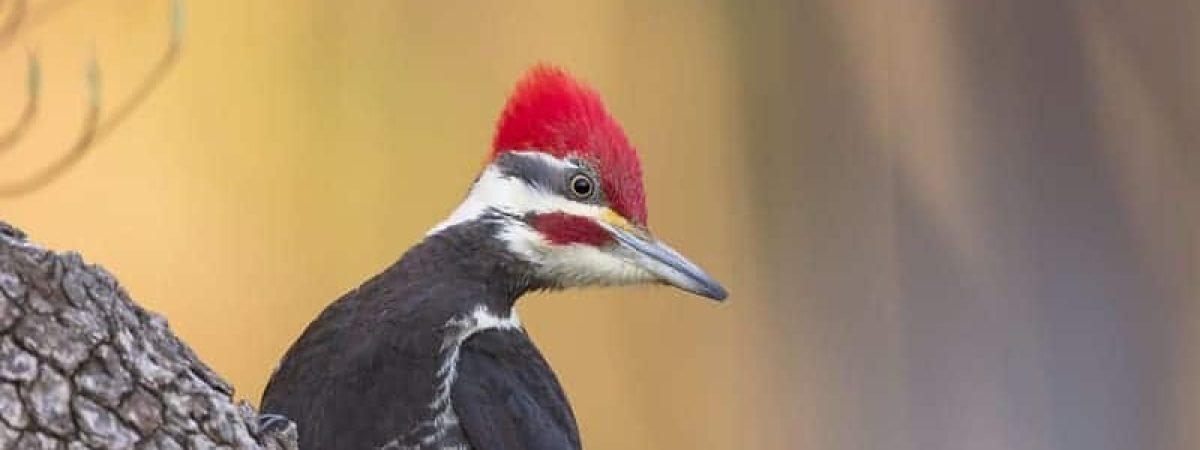
Florida is a vacation destination not only for humans trying to escape cold northern winters, but likewise for migratory woodpeckers seeking a warm asylum.
There are eight woodpecker species that call Florida home year-round, and an additional three species that migrate to Florida each year to spend the autumns or winters down south.
Want to learn more? Take a look at the North American Guide to Woodpeckers
Many woodpeckers are drawn to the pine forests that Florida has to offer, although unfortunately many of these forests are currently being cleared or have already been cleared as a result of the timber industry, and many woodpecker populations have suffered as a result of habitat loss.
A recent study in Florida identified 29 species of birds that are at risk of habitat and population loss due to climate change, including 13 “highly vulnerable” species, with the red-headed woodpecker being one of these 13 highly vulnerable species.
There are many Florida state parks that are known for offering great bird watching opportunities, and this list includes, but is not limited to, Blackwater State Forest, Anastasia State Park, Avalon State Park, and Olustee State Park.
The Blackwater Heritage State Trail is perhaps your best bet of seeing the most woodpecker species, all within one 8.1-mile hike.
This trail is home to the red-cockaded woodpecker, the downy woodpecker, the red-bellied woodpecker, and the pileated woodpecker, in addition to many other non-woodpecker bird species.
Overall, Florida is a paradise of woodpecker watching due to a high number of resident species and easy accessibility, just do your best to support habitat-preserving efforts to keep these unique birds around.
Take a look at our article on How to Attract Woodpeckers?
What Woodpeckers can be seen in Florida?
Table of Contents
1. Gold-Fronted Woodpecker
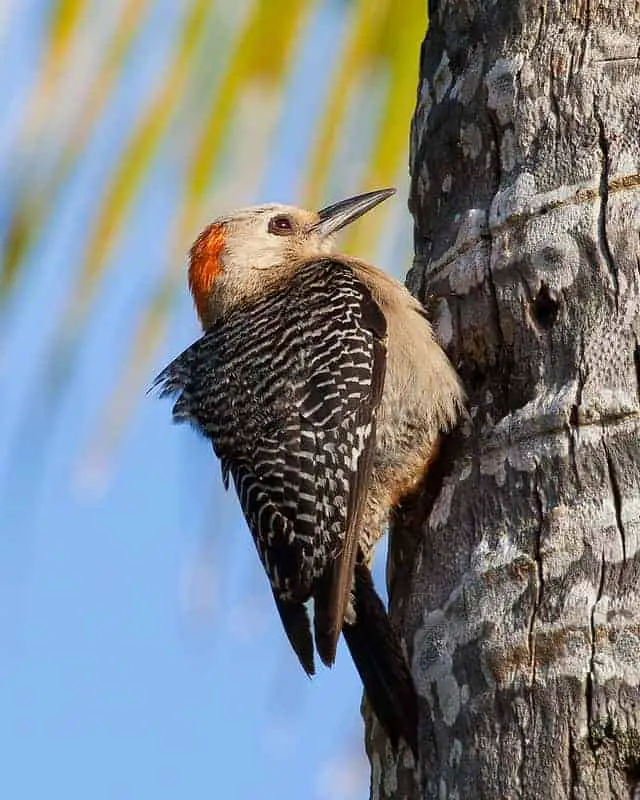
“Gold Fronted Woodpecker- Belize” by ‘Stokes rx‘ is licensed under CC BY 2.0
Wingspan
16.5-17.3 inches
Weight
2.6-3.5 ounces
Life Expectancy
5-6 years
Diet
Small insects, can be drawn to feeders with oranges and jelly
The Golden-fronted Woodpecker is aptly named due to its tan/gold front colouring.
In addition to this signature characteristic, adult males will have red colouring on the top of their heads and white rumps visible when flying.
Their preferred habitat are spacious woodlands and dry brush.
They can be drawn to feeders using oranges and jam. They are cavity nesters, meaning that they will raise their young, lay eggs, and dwell inside cavities of either birdhouses or trees, or a similar habitat.
Females will have a more distinct yellow colouring on their lower belly. The males can be territorial. They feed on insects such as grasshoppers.
When can this bird be seen in the state?
The golden-fronted woodpecker can be found in Florida at any time of the year.
They are not migratory and stay in the southern United States and Central America for the entire duration of the year.
Where can this bird be seen in the state?
Golden-fronted woodpeckers have been spotted in the north-western part of the state.
You likely won’t see them anywhere on the panhandle of Florida or along the eastern coast, since Florida is on the eastern edge of their range, with their main range being from Texas to Nicaragua, but occasionally they can traverse to western Florida.
2. Red-Bellied Woodpecker
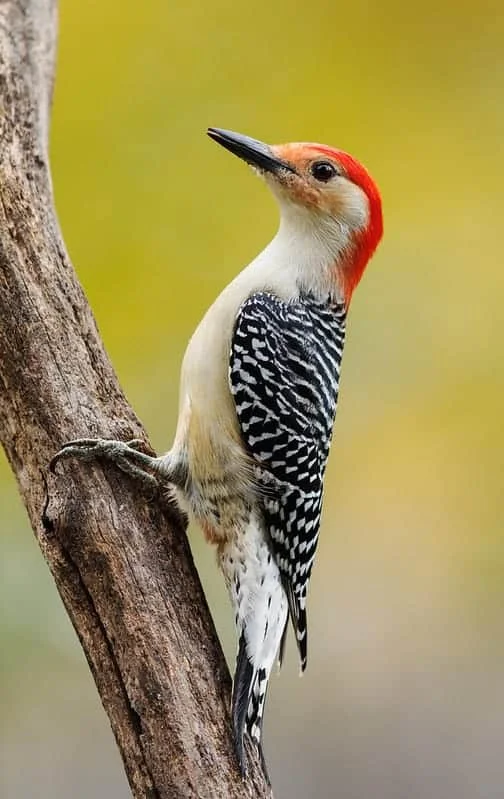
Wingspan
15-18 inches
Weight
2.65 ounces
Life Expectancy
12 years
Diet
Insects
In contrast to the Golden-fronted Woodpecker, the Red-Bellied Woodpecker is not aptly named, since Red-bellied woodpeckers do not have red bellies, or at least not very easily identifiable red colouring on their belly.
Their most identifiable characteristic is the red head for males, otherwise you’ll be able to identify their black and white barring on their back and wings, which is reminiscent of zebra striping.
They can be found in woodlands and even suburban locations, but they generally stay near deciduous trees.
Throughout the years, the range for red-bellied woodpeckers has slightly crept northward. They are cavity nesters.
They have a distinct rolling call that you won’t forget once you hear it.
They have two toes in the front of their foot and two toes in the back, different from most birds who have three in the front and one in the back, and this allows the red-bellied woodpecker to grip vertically on trees easier.
When can this bird be seen in the state?
Red-bellied woodpeckers can be seen in Florida year-round. They are not considered a migratory bird, although there have been observations of some of them flying to more southern locations during the winter.
So, although these woodpeckers are extremely common, it is possible that they could be even more prominent in Florida in the winter.
Where can this bird be seen in the state?
The red-bellied woodpecker can be found all over the state of Florida, although they prefer deciduous trees.
They are very common and aren’t shy of visiting suburban areas, it is highly likely one lives near you if you are a Florida resident.
3. Downy Woodpecker
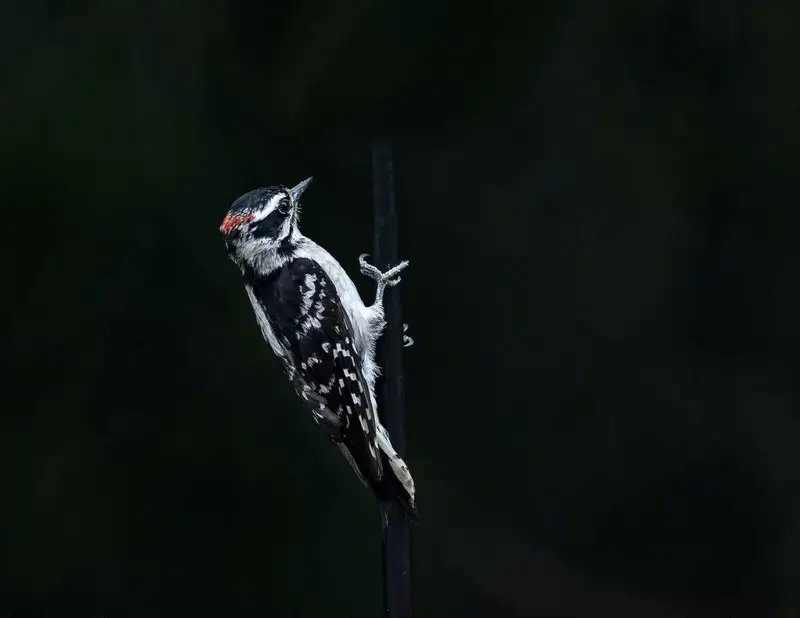
Wingspan
3.27 to 4.13 inches
Weight
0.75 to 1 ounce
Life Expectancy
12 Years
Diet
Insects & Non-insect arthropods
Downy woodpeckers are notably the tiniest woodpecker species in North America, standing at as little as 5.71 inches tall for adults.
They are black and white coloured, with two black shoulder pads on their back with a large white stripe in between. Their wings are black and white horizontal bars, or in some instances black with white spots.
Males are differentiated from females by a red patch on the back of their neck, or at the top of their head in the case of younger males.
Their calls are quieter than most other woodpeckers. Although they prefer spacious deciduous forests in the northern part of their range, in the southern part of their range, they seek woods along riverbanks or ponds and like moist environments.
They are cavity nesters and usually nest in tree limbs.
When can this bird be seen in the state?
Downy woodpeckers can be found in Florida year-round. More frequent sightings have occurred in the fall, from September to late October.
Where can this bird be seen in the state?
Downy woodpeckers can be seen all over the state of Florida, but their populations are less dense the further south you travel on the panhandle.
Since Florida is on the southern portion of their range, you should look for downy woodpeckers near wooded riverbanks, since that is their preference in warmer environments.
4. Red-Cockaded Woodpecker
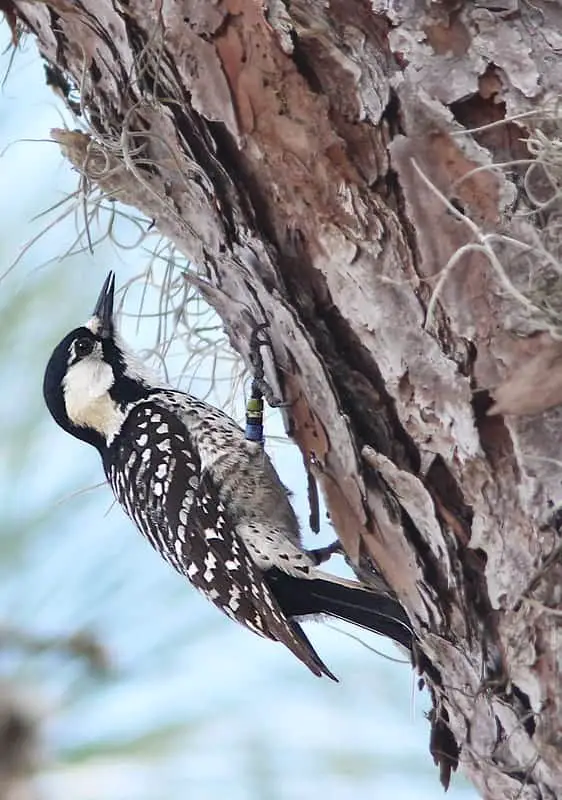
Wingspan
14 inches
Weight
1.5 ounces
Life Expectancy
16 years
Diet
Eggs, insects, nuts, seeds & fruit
Red-cockaded woodpeckers have large white patches on their cheeks along with similar barred black and white markings to the red-bellied woodpecker down their back.
They enjoy living in habitats of old pine forests, especially if these forests are burned from time to time, since they live in cavities in that they dig into the pines.
Red-cockaded woodpeckers live in groups of a breeding couple and an additional male offspring.
The growing offspring will be in charge of digging the nests into the pine trees and later on will be in charge of raising the new offspring.
If necessary, young females might even join the group for breeding purposes.
Since the pine forests in Florida have experienced large amounts of deforestation, these woodpeckers have become endangered.
When can this bird be seen in the state?
The red-cockaded woodpecker can be seen in Florida year-round, although they are uncommon.
They are not migratory and generally stay in the south eastern United States.
Where can this bird be seen in the state?
Red-cockaded woodpecker populations have been declining for the past century due to deforestation and are not as prominent as they once were.
They are found all over Florida, aside from the coastline, and they are more rare than most other woodpeckers on this list. Look for them in pine forests.
5. Hairy Woodpecker
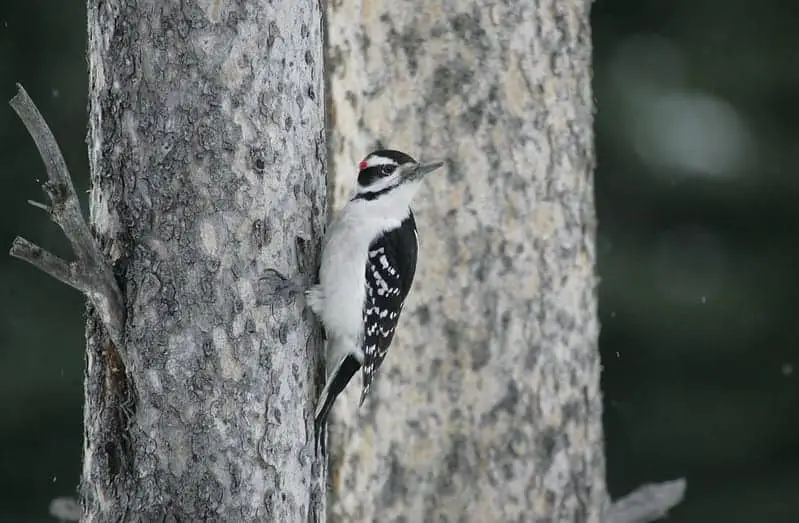
Wingspan
15 inches
Weight
1.4 to 3.4 ounces
Life Expectancy
15 years
Diet
Wood-boring insects & tree sap
Hairy woodpeckers and downy woodpeckers are known for being similar enough that they can be difficult to distinguish and are often found in the same habitats.
The only distinguishable differences between downy woodpeckers and hairy woodpeckers are their size and shape, with hairy being the larger of the two.
Because hairy woodpeckers are larger, they necessitate larger trees to dwell in.
Hairy woodpeckers are also the rarer of the two similar species. They have a high work rate when it comes to boring into trees and are capable of excavating much more than similar sized species.
They excavate deep into trees to eat insects that tunnel in the wood.
The larvae of these insects are one of their favourite foods and are the reason that they are willing to go the extra mile to dig deeper into trees than most woodpeckers would.
They will also feed on sap that leaks out as they excavate.
When can this bird be seen in the state?
Hairy woodpeckers are not migratory and can be seen in Florida during all seasons.
Where can this bird be seen in the state?
Hairy woodpeckers can be seen all over the state of Florida, although they are relatively uncommon there.
They also have a large range overall and can be found almost over the entire United States and Canada and even part of Mexico.
In the Eastern United States, they generally will nest in deciduous trees in the winter season.
6. Ivory-billed Woodpecker (Extremely Rare)
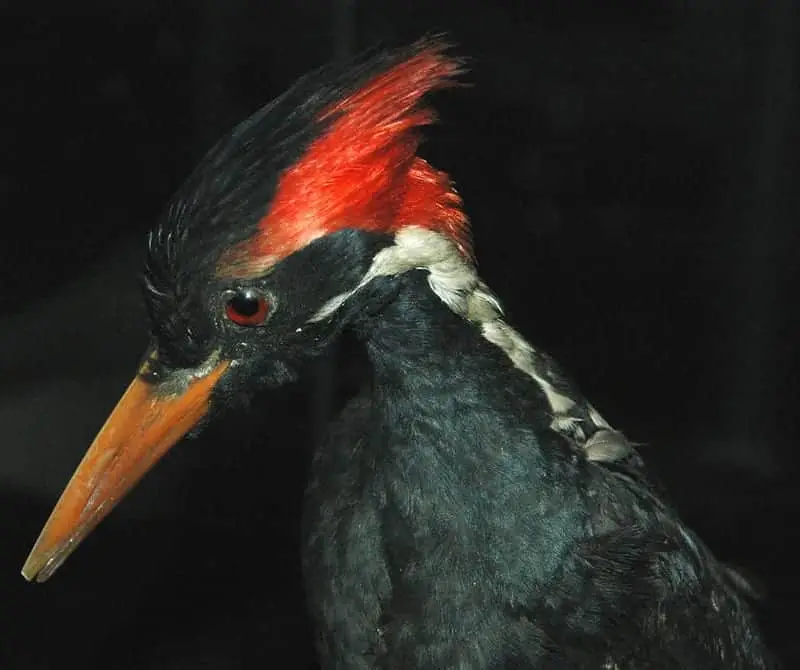
“Campephilus principalis (ivory-billed woodpecker) 3″
by ‘James St John‘ is licensed under CC BY 2.0
Wingspan
30 inches
Weight
16-20 ounces
Life Expectancy
20-30 years
Diet
Insect larvae & fruit
Ivory-billed woodpeckers are extremely rare. They are known to nest earlier in the spring than many other woodpeckers, many believe it is to shelter from spring rains.
To provide cover for these rains, they often dig their cavity nests below a large tree branch to offer themselves an awning of sorts.
The male ivory-billed woodpeckers have a red spot on the top of their head, somewhat similar to that of a pileated woodpecker.
They also greatly enjoy eating from grapevines, it is an irresistible snack for ivory-billed woodpeckers.
They are vicious excavators, and if they find a particular tree of interest, you will likely see a large pile of wood chips at the base after a day or two.
They like living among cypress trees in swamps and also locations where swamp meets forest. They are one of the largest woodpeckers in the world. The ivory-billed woodpecker is believed to be almost extinct.
When can this bird be seen in the state?
Ivory-billed woodpeckers are not migratory and can be found in Florida during all seasons.
Where can this bird be seen in the state?
Ivory-billed woodpeckers are some of the rarest woodpeckers in the world. Rarely have they been spotted in the 21st century. You might want to buy a lottery ticket too if you catch a glimpse of this elusive bird!
7. Pileated Woodpecker
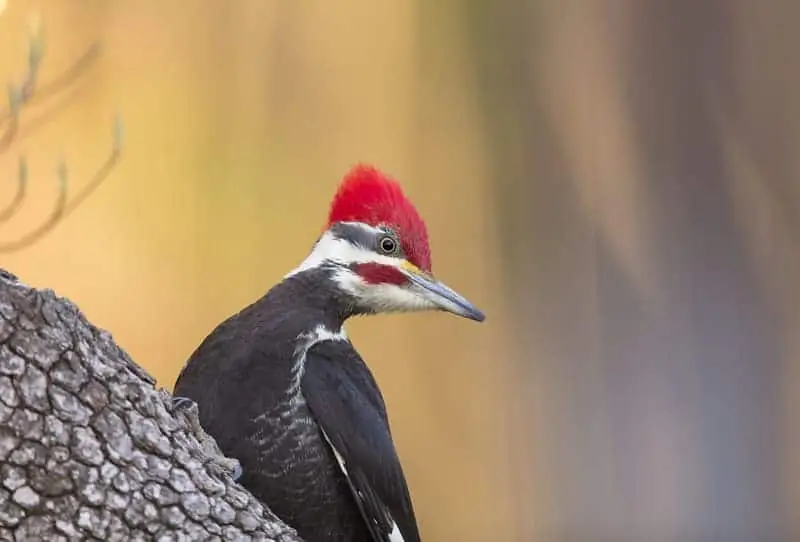
Wingspan
26 to 30 inches
Weight
8.8 to 14.1 ounces
Life Expectancy
13 years
Diet
Fruit, nuts & insects
Pileated woodpeckers are some of the most easily identifiable birds due to their large red crest on top of their heads.
If the ivory-billed woodpecker is extinct, as many bird watchers believe it is, then that make the pileated woodpecker the largest woodpecker in North America.
You can track pileated woodpeckers due to their iconic rectangular holes that they leave when excavating for carpenter ants.
They used to be much more common than they are today, but their population has been decreasing.
Florida and the south east United States are the most common area to find pileated woodpeckers. They will also eat berries by balancing with surprising agility on vines and small branches for their large size.
They mark their territory by loudly pecking and letting out loud calls. They live in dead trees or tree limbs in cavities and are even commonly found burrowing into utility poles.
When can this bird be seen in the state?
Pileated woodpeckers live in Florida throughout all seasons. However, they are sometimes capable of covering large areas and might move great distances.
Where can this bird be seen in the state?
Pileated woodpeckers are found all over the state of Florida, they are some of the less picky woodpeckers in terms of habitat and are even found near large cities or in areas of high human traffic.
They prefer to search for food and live in dead trees and tree limbs.
8. Yellow-Bellied Sapsucker
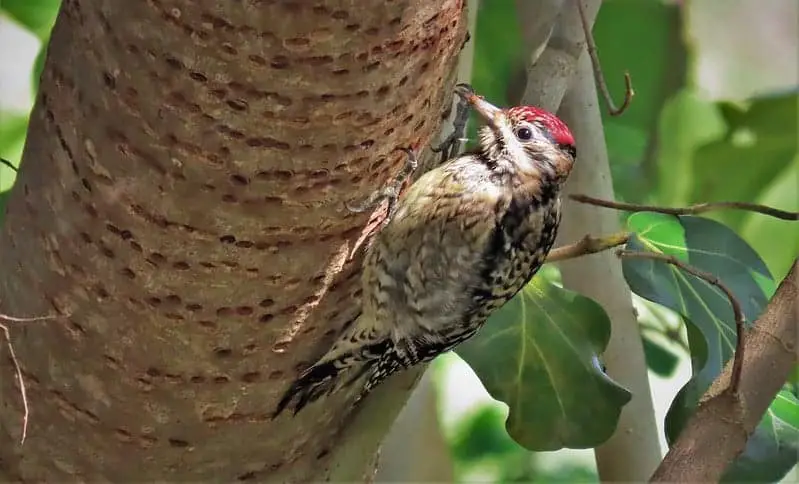
Wingspan
13 to 16 inches
Weight
1.5 to 1.9 ounces
Life Expectancy
7 years
Diet
Tree sap, insects & fruit
Yellow-bellied sapsuckers are only a temporary resident of Florida, and they do not breed in Florida.
They are migratory and are usually only found in Florida in the winter months on their way to locations further south such as Cuba.
They get their name from their affinity for drinking sap from trees, but they also feed on fruit and insects that are attracted to the sweet sap that they uncover.
An important aspect of their mating process is habitat selection, and females will breed with males who have a favourable habitat.
As their name suggests, their underside has a yellow tint to it, and they have a distinct white line that runs along their folded wings.
Their genders can be differentiated by their throat colours, for males it will be red and for females it will be white.
Their location can be tracked by looking out for neat horizontal rows of small punctures in the tree trunk or branches where sap will leech out of.
The sapsuckers will continually return to sap wells that they have created as it will continue to drip sap.
When can this bird be seen in the state?
Sapsuckers are migratory and will only be found in Florida in the winter, and often for brief periods of time, since their end destination is usually Cuba or a more southern location.
Where can this bird be seen in the state?
Sapsuckers can be seen anywhere in the state as they pass through during their migratory journey. Wherever you see them, you likely won’t see them there for long.
9. Northern Flicker
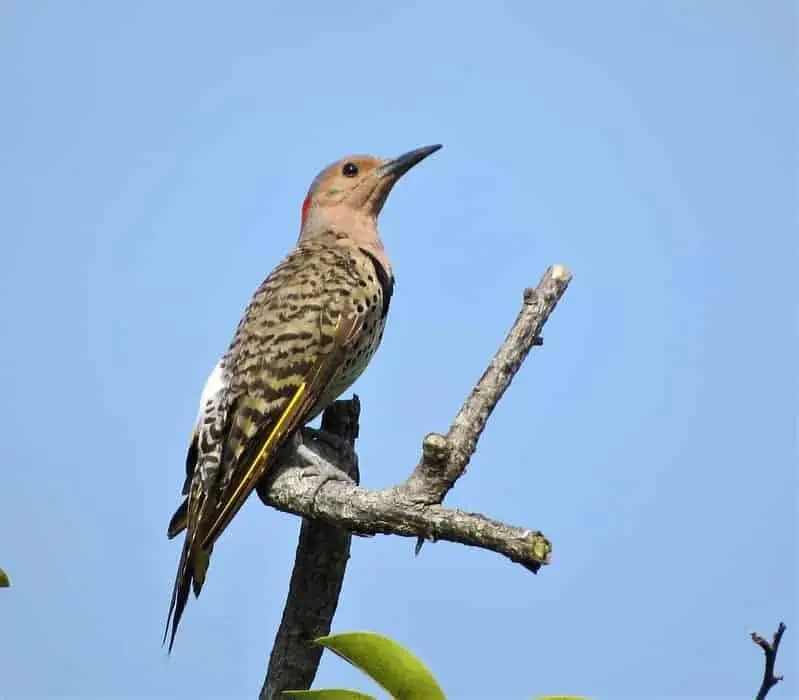
Wingspan
21.3 inches
Weight
6 ounces
Life Expectancy
9 Years
Diet
Insects, seeds, nuts & fruit
Northern flickers have a large range and are found in all corners of North America.
Compared to other woodpeckers, northern flickers are not expert excavators, and rather than excavating their own cavity nest, they usually will seek refuge in a naturally occurring cavity.
If you want to attract northern flickers to your birdhouse, ensure that you line it with wood shavings, otherwise they will not stay there.
Although they are seen in Florida year-round, they are much more prominent in the winter months. Their colouring is earthy in hue with a black marking on its chest.
Males can be differentiated from females by identifying black marks on their cheeks that make it look like they have a moustache.
Northern flickers are split into eastern and western subsets, and the eastern variation will sport yellow underneath their wings, and the western variation will sport red underneath their wings.
Also, since they are not as skilled at excavating as many of their relatives, they are more reliant on eating food found on the ground, such as ants and beetles.
It is possible that you’ll see them on the ground more than you will in a tree, an unusual characteristic for a woodpecker species.
When can this bird be seen in the state?
Northern flickers can be seen in Florida throughout all seasons.
Where can this bird be seen in the state?
Northern flickers can be found in all parts of Florida. Look for them to live in naturally occurring cavities. Outside of their homes, they will likely be hunting for insects on the ground.

More Articles.
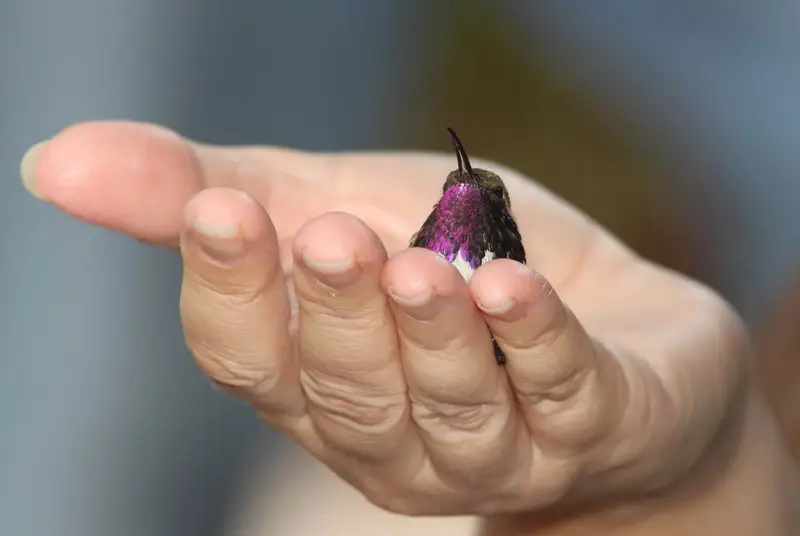
Can you keep a Hummingbird as a Pet in the US?
In the US, it is in fact illegal to keep hummingbirds as pets in your
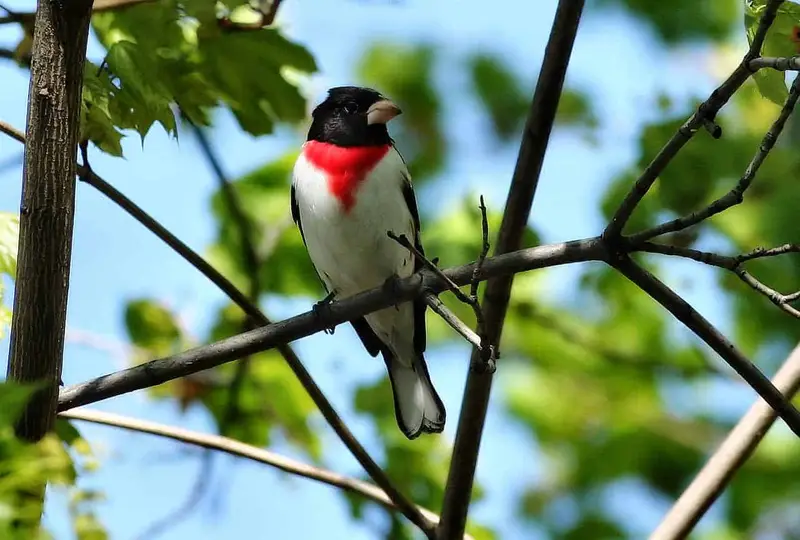
How to Attract Grosbeak to your Yard?
Grosbeak are a medium sized bird that is known to spend time visiting a great
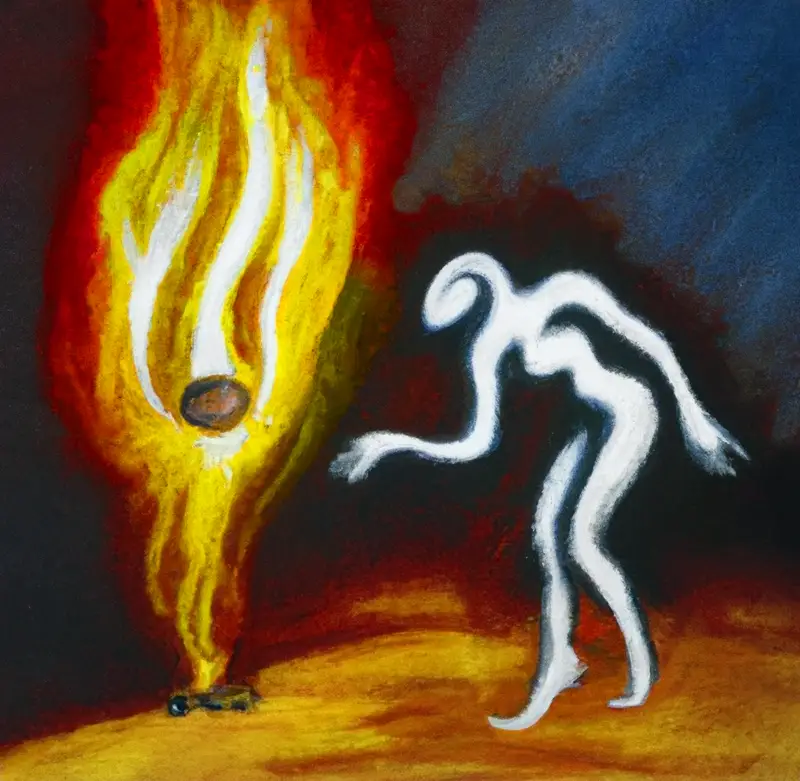
What does it mean to see a Phoenix in your dream? (Symbolism and Meaning)
Seeing a Phenoix in your dream can symbolize a fresh start, a new beginning, or

About Us
We are avid bird-watchers who recently retired, allowing us more time to travel the world. Fortunately, we have managed to visit numerous countries around Europe, Asia, and America. Watching and photographing birds has been a passion for many years and we are making the most of the extra time on our hands!

Hi. My wife Renee and I recently moved to Stuart Florida. As I write this we observed two wood peckers in our tropical trees in the back yard. One appeared to feed on a “Bird of Paradise” flower. Thanks toyour informative article, we identified them as “Red Bellied Woodpeckers”.
Thank you for this information. I live on the coast in Central Florida. In New Smyrna Beach area. I was out fishing and saw a pileated woodpecker I was telling the people on the boat about them. After reading your article I had more information. I had thought they were endangered. Glad to hear that they weren’t. Thank you
Just spotted a Pileated Woodpecker. First one I have ever seen. Came to our porch just outside Panama City, Florida.
Just saw black woodpecker with brown head top tuft….n.fla.
Any ideas as to I.D.